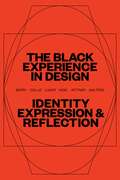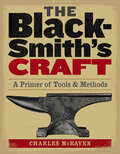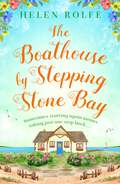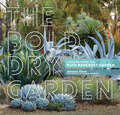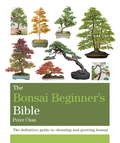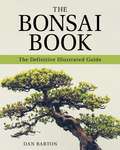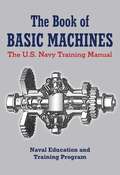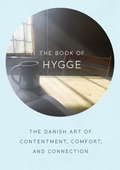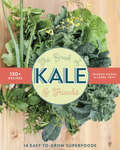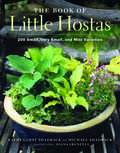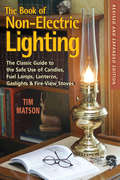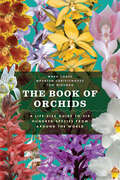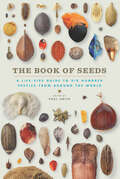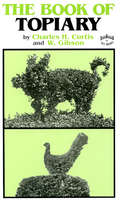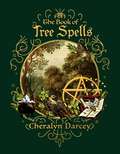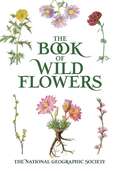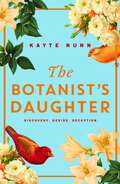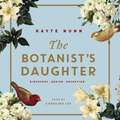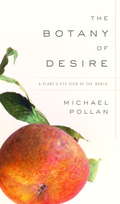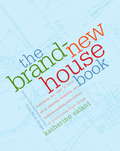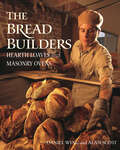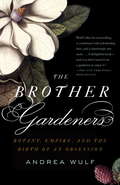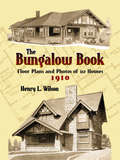- Table View
- List View
The Black Experience in Design: Identity, Expression & Reflection
by Anne H. BerryThe Black Experience in Design spotlights teaching practices, research, stories, and conversations from a Black/African diasporic lens. Excluded from traditional design history and educational canons that heavily favor European modernist influences, the work and experiences of Black designers have been systematically overlooked in the profession for decades. However, given the national focus on diversity, equity, and inclusion in the aftermath of the nationwide Black Lives Matter protests in the United States, educators, practitioners, and students now have the opportunity—as well as the social and political momentum—to make long-term, systemic changes in design education, research, and practice, reclaiming the contributions of Black designers in the process.The Black Experience in Design, an anthology centering a range of perspectives, spotlights teaching practices, research, stories, and conversations from a Black/African diasporic lens. Through the voices represented, this text exemplifies the inherently collaborative and multidisciplinary nature of design, providing access to ideas and topics for a variety of audiences, meeting people as they are and wherever they are in their knowledge about design. Ultimately, The Black Experience in Design serves as both inspiration and a catalyst for the next generation of creative minds tasked with imagining, shaping, and designing our future.
The Blacksmith's Craft: A Primer of Tools & Methods
by Charles McRavenGet that metal hot and start hammering! Setting up your own forge and crafting everyday items is easier than you might think. With simple methods, easy-to-follow photographs, and insightful tips, you’ll soon be creating items of lasting beauty and durability from iron and steel.
The Boathouse by Stepping Stone Bay
by Helen Rolfe'Comforting and uplifting, this book is a joy to read' - MY WEEKLY, on The Farmhouse of Second ChancesSun, sand and secrets at the bay!As a kid, Nina O'Brien spent all her summers at her grandparents' cabin by the beach at Stepping Stone Bay. Long, sunny days full of fun and laughter with her best friends, Leo, Adrian, and Maeve, her friendship with Leo slowly blossoming into love. Until one fateful night changed everything for them all... Twelve years later, Nina must return to the bay to renovate the old cabin and pass it on to a new owner. But not only does Leo still live in the cabin next door, he works at his family's boathouse right there in the bay. As they begin to work through their differences and what happened all those years ago, can Nina really walk away from him twice? Maeve has finally returned home to face the past. Her eleven-year-old son, Jonah, loves the sea, unlike Maeve who is terrified of it. But she knows she can't keep Jonah away from the sea or the truth forever..A heartwarming and uplifting story about second chances and facing the secrets of the past. Perfect for fans of Philippa Ashley, Holly Martin and Ali McNamara. Readers adore Helen's heartwarming storytelling'Enchanting... Employing all the warmth and charm of Maeve Binchy, and a special brand of kindness that she has made her own, Rolfe weaves together elements of mystery, romance, family relationships and the warmth of community in a story guaranteed to bring laughter, tears and miles of smiles' Lancashire Post'A warm, comforting tale of family and community which brims with kindness and love' Annie Lyons'A heartwarming story about family, forgiveness and the importance of kindness... If you're looking for a feelgood novel in these difficult times, this is definitely it!' Fiona Harper'A lovely community, full of friendship and love''I enjoyed every minute of this book and found it very hard to put down''Lovely, feel-good...filled with lots of love''Gave you all the emotions: suspense, happiness and excitement''Helen Rolfe's writing brought a smile to my face''Loved loved loved this fabulous book'
The Bold Dry Garden: Lessons from the Ruth Bancroft Garden
by Johanna Silver Marion Brenner“For those of you—and your numbers are growing—gardening in drought-stricken parts of the country, The Bold Dry Garden will quench your thirst for inspiration.” —New York Times Book Review Ruth Bancroft is a dry gardening pioneer. Her lifelong love of plants led to the creation of one of the most acclaimed public gardens, The Ruth Bancroft Garden in Walnut Creek, California. The Bold Dry Garden offers unparalleled access to the garden and the extraordinary woman responsible for it. In its stunningly photographed pages, you’ll discover the history of the garden and the design principles and plant palette that make it unique. Packed with growing and maintenance tips, profiles of signature plants for a dry garden, and innovative design techniques, The Bold Dry Garden has everything you need to create a garden that is lush, waterwise, and welcoming.
The Bonsai Bible: The Definitive Guide To Choosing And Growing Bonsai (Octopus Bible Ser.)
by Peter ChanThe Japanese and Chinese have been creating bonsai trees for centuries and it is now an internationally popular pastime. This compact and stylish guide will provide everything you need to know to grow bonsai successfully, including shaping with wires, watering, seasonal maintenance, tackling common ailments, choosing the right container, feeding and repotting. A directory of over 90 of the most popular species, illustrated with beautiful photographs, will enable you to find the tree that is right for you.
The Bonsai Bible: The definitive guide to choosing and growing bonsai
by Peter ChanThe Japanese and Chinese have been creating bonsai trees for centuries and it is now an internationally popular pastime. This compact and stylish guide will provide everything you need to know to grow bonsai successfully, including shaping with wires, watering, seasonal maintenance, tackling common ailments, choosing the right container, feeding and repotting. A directory of over 90 of the most popular species, illustrated with beautiful photographs, will enable you to find the tree that is right for you.
The Bonsai Book: The Definitive Illustrated Guide
by Dan BartonThis original and authoritative book is presented in a practical yet inspirational way. Dan Barton shares with us his expert knowledge and two decades of research, giving both detailed step-by-step horticultural instructions and a fascinating insight into the creative process of Bonsai, to provide a genuine understanding of the subject. As well as giving the essential descriptions of stock, equipment, basic care, and training techniques, the book includes new methods of achieving quicker results, a Bonsai calendar showing routing tasks on a month-by-month basis, and the use of modern materials, all of great value to today’s Bonsai enthusiast. Beautifully illustrated throughout with strikingly original and instructive photographs, line drawings, and working schedules, The Bonsai Book is a must for would-be Bonsai enthusiasts and experts alike, and its fabulous presentation makes it an ideal gift.
The Book of Basic Machines: The U.S. Navy Training Manual
by U. S. NavyHave you ever wondered why levers and pulleys make it easy to lift heavy objects? Or thought about what it is that makes a combustion engine work?The Book of Basic Machines will give you the information you need to understand key concepts, techniques, components, and much more. Designed and prepared by the Naval Education and Training Program Development Center for naval training, and taught widely in technical school across the country, the manual covers the theory and application of many of the most important mechanical ideas. Concepts build effortlessly from one chapter to the next. Clear explanations, illuminating examples, and over 200 skillfully rendered diagrams, cross-sections, and illustrations make it remarkably easy for readers of any level to understand the fascinating inner-workings of basic machines. The Book of Basic Machines is an invaluable resource for mechanical engineering students looking to learn the basics, working engineers wanting to brush up on some theory, or hobbyists who simply want to know how things work. Simply put, this book is required reading for anyone interested in machines. From the basics of simple levers to the principles of the internal combustion engine, The Book of Basic Machines covers every aspect of basic machinery.
The Book of Hygge: The Danish Art of Contentment, Comfort, and Connection
by Louisa Thomsen Brits“The most poetic of the [hygge books]; I found myself repeatedly returning to its list-like incantation of hyggeligt habits.” —Louisa Kamps, ELLEHygge (hoo-gah) is a Danish word but a universal feeling of being warm, safe, comforted, and sheltered—an experience of belonging to the moment and to each other. When life gets hectic, work grows stressful, and the days fly by, unplug and tune in. Hygge anchors us, reminding us to slow down, to connect with place and with one another, to dwell and savor rather than rush and spend. When you curl up by the fire with a blanket, or have a simple meal with friends, that is hygge. When you acknowledge the sacred in the secular, or focus on people rather than things, or when you express love through small gestures, that is hygge. The Book of Hygge is an invitation to welcome abundance and contentment into your life. It is a call to live more fully by focusing on what moves you. With beautiful full-color photographs and instructive meditations on relishing the everyday, it is your perfect guide to cultivating the coziness that has made Danes the happiest people in the world. The Book of Hygge is designed with an unjacketed, textured cover and crisp, clean interiors.As seen in the The New Yorker, a cure for SAD in book form.
The Book of Kale and Friends
by Sharon Hanna Carol PopeFollowing the success of her bestseller, The Book of Kale, Sharon Hanna is back, teaming up with gardening editor Carol Pope, for even more fun with kale in The Book of Kale and Friends. There are good reasons why the Kale Revolution is growing--this humble leafy green is one of the healthiest vegetables on earth, it thrives in winter and sweetens in the cold, it self-seeds, its flowers sustain bees, and it's so easy to grow you will feel like a master gardener with almost no effort. With the seemingly limitless ways to enjoy this superfood--kale salad, kale chips, kale pizza, kale soup, kale pesto, and even kale cookies--one book just wasn't enough.Kale, available in so many gorgeous varieties, grows well in pots, and anyone with a balcony, back porch or limited outdoor space can access fresh, tender leaves year-round. In addition to more tips on kale cultivation, Sharon and Carol invite readers to branch out with thirteen other superfood crops that are equally easy to grow, as well as nutritious and versatile in the kitchen. With advice on growing and using arugula, basil, chives, cilantro/coriander, herb fennel, garlic, kale, lovage, mint, oregano, parsley, rosemary, sage and thyme, readers can save hundreds of dollars a year on grocery bills.After the garden is planted, celebrate with over 130 recipes, including Kale Cilantro Chimichurri, Potato-Crusted Kale and Smoked Salmon Tart, and Kalelicious Chocolate Cake. With abundant vegetarian, vegan and glutenfree options, The Book of Kale and Friends has something to please everyone. Even the family pooch is invited to enjoy the healthy harvest with Kale Doggy Biscotti!
The Book of Little Hostas: 200 Small, Very Small, and Mini Varieties
by Kathy Guest Shadrack Michael ShadrackHostas are irresistible. Their sculptural leaves and appealing textures make it difficult to stop at one, and it is easy to fill a garden with them. Help is at hand with this attractive guide to the popular new small hostas that take up less space and are ideally suited to container cultivation. They can be used on their own or with companion plants to make charming displays on the patio, porch, or even windowsill. Many small hostas are simply scaled-down versions of classic hostas, while others offer distinctly new attributes in terms of color, leaf shape, and patterning. Like full-size hostas, small hostas can be upright, flat, or cascading; there are varieties that are full of substance, and others that are fine and delicate; there are green ones, gold ones, blue ones, variegated ones, and splashed ones. Some are better garden plants than others, and a valuable function of this book is to showcase the very best of the new introductions. Photographs of the hostas in garden settings show how admirably they respond to imaginative display in a wide range of situations including waterside, woodland, and rock gardens. Beautifully illustrated and highly informative, this handpicked selection of diminutive hostas will inspire hobbyists and gardeners alike and provide inspiration for new planting schemes.
The Book of Non-electric Lighting: The Classic Guide to the Safe Use of Candles, Fuel Lamps, Lanterns, Gaslights & Fire-View Stoves
by Tim MatsonTim Matson surveys an often overlooked aspect of independent living—firelight. In this completely revised and updated classic, Matson describes in lively detail all the elements of firelight—beginning with an explanation of the lighting system he developed from his Vermont home. • The romantic history and modern molding of candlepower • Traditional kerosene lamps • The versatile Aladdin • Liquid propane (LP) gas lights • Kerosene and gas pressure lanterns (the Coleman) • Incandescent mantle safety • The "Return of Firelight" from glass-fronted hearths and stoves In addition, Matson shows how to select, assemble, install, and safely maintain these non-electric sources of light. This guide will be indispensable for vacation homes, camps, boats, RVs, independent homesteads—and anywhere in a blackout.
The Book of Orchids: A Life-Size Guide to Six Hundred Species from Around the World
by Tom Mirenda Mark Chase Maarten Christenhusz“Clear, informative text. It is a superb production, reminding us of the astonishing diversity of these plants.” —Times Literary SupplementOne in every seven flowering plants on earth is an orchid. Yet orchids retain an air of exotic mystery—and they remain remarkably misunderstood and underappreciated. The orchid family contains an astonishing array of colors, forms, and smells that captivate growers from all walks of life across the globe. Though undeniably elegant, the popular moth orchid—a grocery store standard—is a bland stand-in when compared with its thousands of more complex and fascinating brethren, such as the Demon Queller, which grows in dark forests where its lovely blooms are believed to chase evil forces away. Or the Fetid Sun-God, an orchid that lures female flies to lay their eggs on its flowers by emitting a scent of rancid cheese.The Book of Orchids revels in the diversity and oddity of these beguiling plants. Six hundred of the world’s most intriguing orchids are displayed, along with life-size photographs that capture botanical detail, as well as information about distribution, peak flowering period, and each species’ unique attributes, both natural and cultural. With over 28,000 known species, the orchid family is the largest and most geographically widespread of the flowering plant families. Including the most up-to-date science and accessibly written by botanists Mark Chase, Maarten Christenhusz, and Tom Mirenda, each entry in The Book of Orchids will entice researchers and orchid enthusiasts alike.“A luscious coffee-table tome.” —Nature
The Book of Seeds: A Life-Size Guide to Six Hundred Species from around the World
by Paul Smith<p>Seeds are nature’s consummate survivors. The next time you admire a field of waving green grassland or a stunning grove of acacia, stop to consider how it got that way—often against incredible odds. Seeds can survive freezing temperatures and drought. They can pass through our digestive systems without damage and weather a trip across the ocean, hitching a ride on marine debris. They can even endure complete desiccation, a feat taken to extraordinary lengths by the date palm, a seed from which was recovered from the palace of Herod the Great was germinated after some two thousand years. <p>The Book of Seeds takes readers through six hundred of the world’s seed species, revealing their extraordinary beauty and rich diversity. Each page pairs a beautifully composed photo of a seed—life-size, and, in some cases, enlarged to display fine detail—with a short description, a map showing distribution, and information on conservation status. The whole spectrum of seeds is covered here. <P>There are prolific species like corn and less widely distributed species, like the brilliant blue seeds of the traveler’s palm or the bird of paradise flower, aptly named for its distinctive orange coiffure. There are tiny seeds and seeds weighing up to forty pounds. And while seeds in all their shapes, sizes, and colors grant us sustenance, there are even some we would be wise to treat with caution, such as the rosary pea, whose seeds are considered more toxic than ricin. <P>The essential guide to these complex plant creations, The Book of Seeds offers readers a rare, up-close look that will inspire scientists and nature lovers alike.
The Book of Topiary
by W. Gibson Charles H. CurtisTopiary, the art of trimming hedges, shrubs, and trees into ornamental shapes, is perhaps the most distinct and fascinating branch of landscape horticulture.Its best known example, the palace gardens of Versailles, stands as a splendid monument to perfection, but today many a finely clipped privet and sheared yew are to be found in the humbler gardens of rural England. This book, first published in 1904, is a classic in the subject, written by two foremost experts of the day: Charles H. Curtis, a Fellow of the Royal Horticultural Society and formerly at Kew Gardens near London, and W. Gibson, head gardener of one of the finest topiary gardens in Britain at Levens Hall. Gibson here draws on a wealth of practical experience to provide sound advice to aspiring topiarists. His practical sections include The Formation of a Topiary Garden, Planting, and TheTraining of Young Trees. Curtis traces the long history of topiary from itsearly origins in ancient Greece. As Homer's description (rendered by Pope) has it: Here interwoven branches form a wall, And from the living fence green turrets rise; There ships of myrtle sail in seas of box; A green encampment yonder meets the eye. The 1500s saw the dawn of the "golden age" of topiary. It extravagances were manifold and characterized the gardens walked by Elizabeth I,Shakespeare, and Raleigh. The extraordinary hedge labyrinth in the grounds of Hampton Court survives today for the pleasure and delight of countless visitors.Any fashion taken to excess leads to an inevitable reaction; and so it was that topiary became the butt of the eighteenth critics. Addison and Pope employed their razor wit in its ridicule. The humor of Pope's satirical description is hard to escape: "St. George in box; his arm scarce long enough, will be in condition to stick the dragon by next April. . . . A quickset hog, shot up into a porcupine, by its being forgot a week in rainy weather." This century has seen a welcome revival of the art. Wealthy patrons of horticulture have laid outtopiary gardens, designed to be in harmony with their formal surroundings and with the natural features of the grounds. There are also many private enthusiasts who, inspired by the feats of the masters, skillfully train their garden hedges into spirals, serpentine columns, and even spires topped by peacocks. Here then is an intriguing read on a too little known subject. The numerous illustrations included add to the interest, and practical instructionsare offered for those tempted to take up the scissors.
The Book of Tree Spells
by Cheralyn DarceyThe story of cricket is littered with big stories, like Bodyline, underarm balls and tycoons changing the game. But, like Tony Greig checking out the pitch with his keys, sometimes things fall through the cracks. Sticky Wickets takes a look at stories both big, small and perhaps forgotten. From bees and their dislike of cricket to a storm caused when a cameraman criticised a Test player's fielding. It's perfect to pick up when rain delays play.
The Book of Wild Flowers: Color Plates of 250 Wild Flowers and Grasses
by The National Geographic SocietyThis wonderful volume, assembled from National Geographic magazines dating 1915–24, spotlights some of the finest botanical imagery of its kind, including artwork by Mary E. Eaton, staff illustrator of the New York Botanical Garden. More than 120 color plates.
The Botanist's Daughter: The most gripping and heartwrenching historical novel you'll read in 2020!
by Kayte Nunn'The whole book is a delight... Perfect reading whilst sipping a g & t in a beautiful garden somewhere in the sun!' Rosanna LeyA buried secret... Present day: Anna is focused on growing her new gardening business and renovating her late grandmother's house. But when she discovers a box hidden in a wall cavity, containing water colours of exotic plants, an old diary and a handful of seeds, she finds herself thrust into a centuries-old mystery. One that will send her halfway across the world to Kew Gardens and then onto Cornwall in search of the truth.A lady adventurer...1886: Elizabeth Trebithick is determined to fulfil her father's dying wish and continue his life's work as an adventurer and plant-hunter. So when she embarks on a perilous journey to discover a rare and miraculous flower, she will discover that the ultimate betrayal can be found even across the seas...Two women, separated by centuries. Can one mysterious flower bring them together?Readers and authors love The Botanist's Daughter:'I loved this book and really look forward to reading the next book by Kayte Nunn; perfect for reading in the garden with a glass of something cold.' Bookliterat'Fast-moving and full of surprises...while delivering a poignant and heart-warming story of romance and new beginnings ' Kate Forsyth'The Botanist's Daughter is a quick paced but mysterious read, which transports you across time and place and is filled with an abundance of flowers.' Foreword Books'A sweeping and exotic read. I was completely swept away. Perfect for readers of Kate Morton.' Lorna Cook'The Botanist's Daughter is an intriguing story about the strength of women who, for their own reasons, are willing to travel halfway across the world and end up with the same goal. It's also a family mystery that slowly reveals its secrets, just like a blooming flower.' The Bookish Gurl 5/5 stars
The Botanist's Daughter: The most gripping and heartwrenching historical novel you'll read in 2020!
by Kayte Nunn'The whole book is a delight... Perfect reading whilst sipping a g & t in a beautiful garden somewhere in the sun!' Rosanna LeyA buried secret... Present day: Anna is focused on growing her new gardening business and renovating her late grandmother's house. But when she discovers a box hidden in a wall cavity, containing water colours of exotic plants, an old diary and a handful of seeds, she finds herself thrust into a centuries-old mystery. One that will send her halfway across the world to Kew Gardens and then onto Cornwall in search of the truth.A lady adventurer...1886: Elizabeth Trebithick is determined to fulfil her father's dying wish and continue his life's work as an adventurer and plant-hunter. So when she embarks on a perilous journey to discover a rare and miraculous flower, she will discover that the ultimate betrayal can be found even across the seas...Two women, separated by centuries. Can one mysterious flower bring them together?Readers and authors love The Botanist's Daughter:'I loved this book and really look forward to reading the next book by Kayte Nunn; perfect for reading in the garden with a glass of something cold.' Bookliterat'Fast-moving and full of surprises...while delivering a poignant and heart-warming story of romance and new beginnings ' Kate Forsyth'The Botanist's Daughter is a quick paced but mysterious read, which transports you across time and place and is filled with an abundance of flowers.' Foreword Books'A sweeping and exotic read. I was completely swept away. Perfect for readers of Kate Morton.' Lorna Cook'The Botanist's Daughter is an intriguing story about the strength of women who, for their own reasons, are willing to travel halfway across the world and end up with the same goal. It's also a family mystery that slowly reveals its secrets, just like a blooming flower.' The Bookish Gurl 5/5 stars
The Botany of Desire: A Plant's-Eye View of the World
by Michael PollanThe book that helped make Michael Pollan, the New York Times bestselling author of Cooked and The Omnivore’s Dilemma, one of the most trusted food experts in AmericaIn 1637, one Dutchman paid as much for a single tulip bulb as the going price of a town house in Amsterdam. <P><P>Three and a half centuries later, Amsterdam is once again the mecca for people who care passionately about one particular plant—though this time the obsessions revolves around the intoxicating effects of marijuana rather than the visual beauty of the tulip. <P>How could flowers, of all things, become such objects of desire that they can drive men to financial ruin? <P>In The Botany of Desire, Michael Pollan argues that the answer lies at the heart of the intimately reciprocal relationship between people and plants. <P>In telling the stories of four familiar plant species that are deeply woven into the fabric of our lives, Pollan illustrates how they evolved to satisfy humankinds’s most basic yearnings—and by doing so made themselves indispensable. <P>For, just as we’ve benefited from these plants, the plants, in the grand co-evolutionary scheme that Pollan evokes so brilliantly, have done well by us <P>. The sweetness of apples, for example, induced the early Americans to spread the species, giving the tree a whole new continent in which to blossom. So who is really domesticating whom? <P>Weaving fascinating anecdotes and accessible science into gorgeous prose, Pollan takes us on an absorbing journey that will change the way we think about our place in nature.
The Brand-New House Book
by Katherine SalantFrom the first vague ideas to the finished structure, building a brand-new house presents you with thousands of choices -- and possible pitfalls. Yet there's no single expert you can turn to at every stage and ask, "What do I do?" Until now. This definitive reference will help you:* Figure out how much house you need, and how much you can afford* Choose among types of builders, communities, and lots* Negotiate the offer, financing, contract, and closing* Assess options and upgrades -- which are worth it and which are not* Understand windows, flooring, kitchens, landscaping, and scores of other issues* Work with real-estate agents, architects, site superintendents, home inspectors, attorneys -- your whole team, which may consist of dozens of playersThe Brand-New House Book distills the most crucial advice from hundreds of experts -- from the broad strokes such as bankers on mortgages, interior designers on colors, or arborists on trees to fine-tuning such as cleaners on carpets, movers on staircases, or landscape architects on drainage, every issue is addressed. Thorough and authoritative, yet completely accessible, this book is the most valuable investment you can make to ensure that you bypass the potential nightmares and ultimately come home to the house of your dreams.
The Bread Builders: Hearth Loaves and Masonry Ovens
by Alan Scott Daniel WingCreating the perfect loaf of bread–a challenge that has captivated bakers for centuries–is now the rage in the hippest places, from Waitsfield, Vermont, to Point Reyes Station, California.Like the new generation of beer drinkers who consciously seek out distinctive craft-brewed beers, many people find that their palates have been reawakened and re-educated by the taste of locally baked, whole-grain breads. Today&’s village bakers are finding an important new role–linking tradition with a sophisticated new understanding of natural levens, baking science and oven construction.Daniel Wing, a lover of all things artisanal, had long enjoyed baking his own sourdough bread. His quest for the perfect loaf began with serious study of the history and chemistry of bread baking, and eventually led to an apprenticeship with Alan Scott, the most influential builder of masonry ovens in America.Alan and Daniel have teamed up to write this thoughtful, entertaining, and authoritative book that shows you how to bake superb healthful bread and build your own masonry oven. The authors profile more than a dozen small-scale bakers around the U.S. whose practices embody the holistic principles of community-oriented baking based on whole grains and natural leavens.The Bread Builders will appeal to a broad range of readers, including:Connoisseurs of good bread and good food.Home bakers interested in taking their bread and pizza to the next level of excellence.Passionate bakers who fantasize about making a living by starting their own small bakery.Do-it-yourselfers looking for the next small construction project.Small-scale commercial bakers seeking inspiration, the most up-to-date knowledge about the entire bread-baking process, and a marketing edge.James Beard Kitchen Aid Book Award (Writing on Food) Winner!
The Breeder's Exception to Patent Rights
by Viola PriftiThis book is the first to analyze the compliance of different types of a breeder's exception to patent rights with article 30 of the Agreement on Trade-Related Aspects of Intellectual Property Rights. This type of exception allows using protected biological matter for breeding new varieties of plants. The breeder's exception is widely accepted under plant variety legislation, but it is not common under patent laws despite the fact that patent rights often cover plant varieties. Only few European countries have adopted such an exception. After the entry into force of the Agreement on a Unified Patent Court, the exception will be mandatory for all European Union Member states. Based on a legal and economic approach, this book offers guidance to those countries that need to incorporate a breeder's exception into their national patent systems and suggests the importance of the exception for promoting plant breeding activities.
The Brother Gardeners: Botany, Empire and the Birth of an Obsession
by Andrea WulfOne January morning in 1734, cloth merchant Peter Collinson hurried down to the docks at London's Custom House to collect cargo just arrived from John Bartram, his new contact in the American colonies. But it was not reels of wool or bales of cotton that awaited him, but plants and seeds... Over the next forty years, Bartram would send hundreds of American species to England, where Collinson was one of a handful of men who would foster a national obsession and change the gardens of Britain forever, introducing lustrous evergreens, fiery autumn foliage and colourful shrubs. They were men of wealth and taste but also of knowledge and experience like Philip Miller, author of the bestsellingGardeners Dictionary,and theSwede Carl Linnaeus, whose standardised botanical nomenclature popularised botany as a genteel pastime for the middle-classes; and the botanist-adventurer Joseph Banks and his colleague Daniel Solander who both explored the strange flora of Tahiti and Australia on the greatest voyage of discovery of modern times, Captain Cook'sEndeavour. Thisis the story of these men - friends, rivals, enemies, united by a passion for plants - whose correspondence, collaborations and squabbles make for a riveting human tale which is set against the backdrop of the emerging empire, the uncharted world beyond and London as the capital of science. From the scent of the exotic blooms in Tahiti and Botany Bay to the gardens at Chelsea and Kew, and from the sounds and colours of the streets of the City to the staggering vistas of the Appalachian mountains,The Brother Gardenerstells the story how Britain became a nation of gardeners.
The Bungalow Book: Floor Plans and Photos of 112 Houses, 1910
by Henry L. WilsonCozy, charming, and distinctly Californian, the bungalow is an enduring architectural icon. Originally designed to survive earthquakes, the low, rambling structures combined grace, beauty, and comfort at minimum cost.Early in the twentieth century, Los Angeles architect Henry Wilson, who called himself "The Bungalow Man," compiled 112 of the most popular and economic bungalow blueprints of his time in a catalog for would-be homeowners. Complementing each set of prints was an illustration or photograph of the completed house, which most frequently contained two or three bedrooms with closet space, living and dining rooms, a kitchen with pantry, and a bath.An ideal reference for preservationists and restorers, this reprint of Wilson's rare catalog represents a wonderful time capsule and invaluable guide to a popular style of American domestic architecture.
